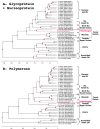A Sporadic and Lethal Lassa Fever Case in Forest Guinea, 2019
- PMID: 32977629
- PMCID: PMC7598168
- DOI: 10.3390/v12101062
A Sporadic and Lethal Lassa Fever Case in Forest Guinea, 2019
Abstract
Lassa fever is a rodent-borne disease caused by Lassa virus (LASV). It causes fever, dizziness, vertigo, fatigue, coughing, diarrhea, internal bleeding and facial edema. The disease has been known in Guinea since 1960 but only anectodical acute cases have been reported to date. In January 2019, a 35-year-old man, a wood merchant from Kissidougou, Forest Guinea, presented himself at several health centers with persistent fever, frequent vomiting and joint pain. He was repeatedly treated for severe malaria, and died three weeks later in Mamou regional hospital. Differential diagnosis identified LASV as the cause of death. No secondary cases were reported. The complete LASV genome was obtained using next-generation sequencing. Phylogenetic analysis showed that this strain, namely the Kissidougou strain, belongs to the clade IV circulating in Guinea and Sierra Leone, and is thought to have emerged some 150 years ago. Due to the similarity of symptoms with malaria, Lassa fever is still a disease that is difficult to recognize and that may remain undiagnosed in health centers in Guinea.
Keywords: Guinea; Kissidougou; Lassa fever; Lassa genome; phylogeny.
Conflict of interest statement
The authors declare no conflict of interest. The funders had no role in the design of the study; in the collection, analyses, or interpretation of data; in the writing of the manuscript, or in the decision to publish the results.
Figures


References
-
- Kafetzopoulou L.E., Pullan S.T., Lemey P., Suchard M.A., Ehichioya D.U., Pahlmann M., Thielebein A., Hinzmann J., Oestereich L., Wozniak D.M., et al. Metagenomic sequencing at the epicenter of the Nigeria 2018 Lassa fever outbreak. Science. 2019;363:74–77. doi: 10.1126/science.aau9343. - DOI - PMC - PubMed
Publication types
MeSH terms
LinkOut - more resources
Full Text Sources

